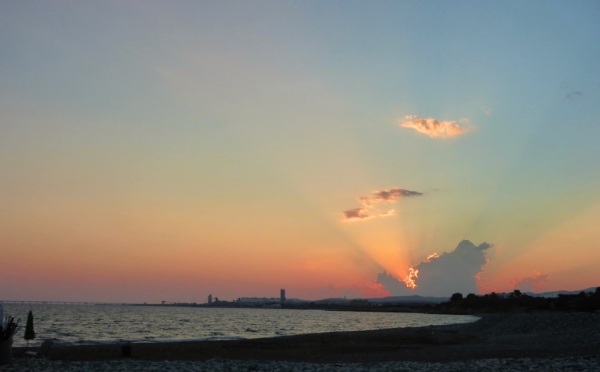In the far east of the Mediterranean Sea, surrounded by Turkey, Syria, Lebanon, Israel and Egypt, you’ll find the fascinating island of Cyprus.

Cyprus map
Cyprus has a rather interesting history. Previously part of the Ottoman Empire, the English colonised Cyprus in 1925 when the Empire fell. Cyprus remained a Crown Colony until its independence in 1960. In 1974 Turkey invaded the North side of the island in a bitter conflict which has resulted in a Cypriot/Turkish split between the island that exists today, requiring passport control to cross the border.
I stayed for 2 weeks near a village called Maroni in the southern part of Cyprus. Here are some of my highlights.
Nicosia
The capital of Cyprus. Half the city resides in Cypriot territory the other in Turkish-Cypriot territory. You can easily go from one side to the other at a number of passport control points, the most popular for tourists being Ledra Street.

Buyuk Han

Dried chillies and garlic at Buyuk Han
Buyuk Han is an old meeting place/square in Turkish Nicosia. It was once a place of trade and provided accommodation for travellers passing through the city. Today, it’s a peaceful place with a restaurant and several shops selling local handmade specialties from clothes to jewellery, artwork and pottery.

Selimiye Mosque
Not far from Buyuk Han is Selimiye Mosque, is the former Roman Catholic Cathedral of Saint Sophia built in the 1300’s before converted into a mosque in 1570 when the under the Ottoman empire.

View from the roof of the Centre of Visual Arts and Research
One of the most interesting museums in Cyprus is the Centre of Visual Arts and Research. Curated by Dr. Rita C. Severis, the museum aims to paint a history of Cyprus through the eyes of artists and travellers over the centuries. There is an immense collection of artwork, maps, artefacts, clothing and costumes from all over Cyprus and its neighbours. Everything is beautifully presented throughout the 4 levels of the museum which also houses a library and research centre containing over 5,000 volumes, available to both scholars and casual readers.

Patio shade in Nicosia

Street Art in Nicosia
Once you’re finished, take in the view of Nicosia from the rooftop bar or enjoy lunch at the beautiful restaurant.
Petra Tou Romiou

Petra Tou Romiou
Aphrodite, the Greek goddess of Love, was not ‘born’ but rather rose from the sea at, according to legend, Petra Tou Romiou. The half-sandy, half-pebbly beach is split in two by a large rock. The legend goes that you’ll have good luck in love if you take a swim around the rock. Let’s see what it brings me!

Taking a dive into the waters at Petra Tou Romiou
Larnaca
Popular amongst tourists, Larnaca is your typical coastal holiday destination. There’s a long stretch of beach, with deck chairs a-plenty, dozens of waterfront cafes, restaurants and bars and abundance of hotels and resorts.

Larnaca
One definite ‘must-do’ in Larnaca is to have a meal at Militzis. Loved by locals and visitors alike, the dish to eat is Kleftiko, a true Cypriot specialty. Kleftiko is lamb seasoned simply with salt and pepper, cooked overnight by the embers in a clay oven. This was by far my favourite meal in Cyprus, the meat literally fell off the bone before melting in my mouth. I’m not normally a potato person but when slow-cooked in the meat’s juices they are a force to be reckoned with. Add a fresh village salad and glass of red wine and heaven isn’t far away!

Kleftiko

Hala Sultan Tekke Mosque
Of cultural interest, the rustic Saint Lazarus church, in nearby Kitiou, houses some of the oldest icons amongst the Greek Orthodox churches, and the Hala Sultan Tekke Mosque is the 3rd most holy place in the Islamic faith.

Saint Lazarus Church
Stavrovouni Monastery
In an otherwise insignificant region, perched high upon a hill overlooking just about all of Cyprus a group of devout Monks live, study and pray at the Stavrovouni Monastery.

View from Stavrovouni Monastery
It’s possible to drive up the hill but a 1 hour walk on the E4 hiking trail will take you from the bottom of the hill to the Monastery carpark and is a great option for active folk like me. Men can enter and visit the monastery in long pants. Women, however, are not permitted. Women may enter a small chapel located there in the carpark (and of course take in the views of Larnaca and beyond).
Maroni
This is where I resided for my time in Cyprus. I found a large British expatriate community there, enjoying the lifestyle that sunny Cyprus has to offer. The village is a simple, typical Cypriot village with many traditional-style homes, bougainvillea galore, a large church and friendly faces.
Pictures around Maroni:



Some Typical Cypriot Foods
Aforementioned Kleftiko is just one of Cyprus’ typical foods I had the fortune of trying. Cypriot food, like most of the mediterranean is based firstly around an abundance of fresh vegetables and fruit – any restaurant meal will begin with a village salad (lettuce, cucumber, tomato, onion, topped with feta) and olives for no more than 1.50 per person.
Being an island, I expected seafood to play a big part in Cypriot cuisine. However I found that while squid and fish are easily found, the more traditional dishes involve pork or lamb.

Grilled squid
Loukanika and Pastourmas are local sausages. Loukanika is soaked in red wine and smoked while Pastourmas is a little more spicy.

Loukanika
Sheftalia are small pork sausages/meatballs wrapped in the stomach. Halloumi is said to originate from Cyprus and traditionally made from a mix of sheep and goats milk.

Sheftalia with salad and Halloumi
Lountza is a Cypriot cold cut, similar to smoked ham while I can only describe Koupes as being similar to Krokets but better. While they are deep-fried and terribly unhealthy, the minced mixture inside the Kroket is handmade, chunky and spiced with fresh parsley, coriander and garlic.

Koupes with salad and lemon
You’ll notice that many of these traditional dishes are quite salty, thus, every meal in Cyprus is served with fresh lemon as a condiment.
Have you been to Cyprus? What are your favourite places and highlights? Let me know below!

